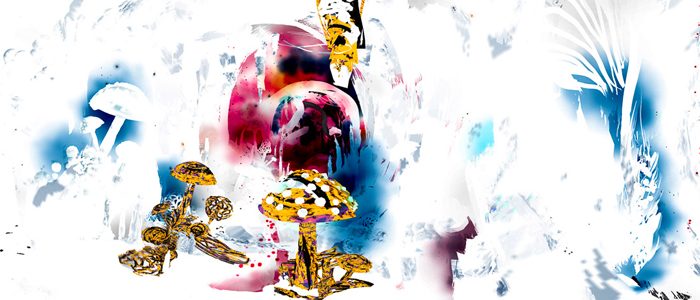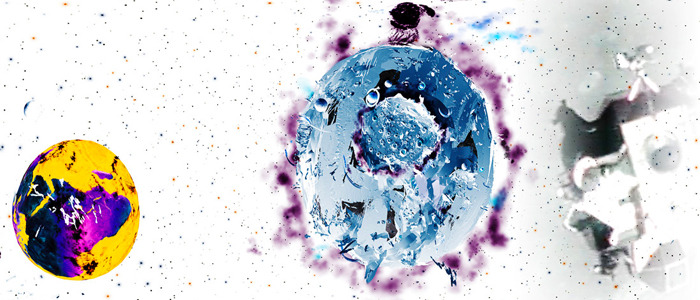'Spaced Out' VR Experience Took Us Literally Underwater On A Journey To A Kaleidoscopic Moon [Sundance 2020]
During the 2020 Sundance Film Festival, I took a trip to the moon.
Spaced Out, a virtual reality experience from French digital artist Pierre "Pyaré" Friquet, is one of the most transporting, immersive things I've ever tried. Donning a bathing suit, a floatation device, and an underwater VR headset equipped with a snorkel, I floated on the surface of a pool while being visually transported across the surface of a psychedelic, kaleidoscopic moon, all set to the actual audio from the real Apollo 11 mission.
The best part? You may be able to experience it yourselves one day, because Pyaré hopes to expand it around the world. Read more about this experience below.
Spaced Out VR Reaction
Spaced Out utilizes technology from a company called Ballast VR, the developer of the world's first underwater VR headset. You may be familiar with their work, since they've had similar VR experiences up and running at resorts and water parks throughout several countries. Here's a video so you can wrap your mind around what this looks like in a practical sense (skip to around the :50 mark to see the virtual reality elements at work):
The feeling of weightlessness and full body immersion is incredible; even though you aren't moving at all on top of the water, the visuals make you feel as if you're slowly sinking down into the depths of this strange new world. Occasionally the path of VR motion changes direction, and again, even though you're not moving at all, it can give the strange feeling that you're being buoyed upward or guided across a horizontal plane. The sounds of astronauts and technicians speaking in your ear, pumped through the pool's underwater speakers to give a sense of distance to it, made me wonder what Buzz Aldrin, Neil Armstrong, and Michael Collins must have felt when they first traveled to uncharted territory.

But Spaced Out isn't interested in putting the "reality" in virtual reality. You don't see our normal, boring-ass grey cratered moon in this thing. Instead, the surface of the moon is full of brightly-colored landscapes, looking like something out of Alice in Wonderland. There are giant mushrooms the size of massive trees, and Seuss-ian designs which shoot up from the planet's surface; if you take a closer look at them as the camera glides you past, it's hard to tell if they're organic or if they're the result of some far-futuristic technology. It all contributes to an incredible sense of otherworldliness, and as the nine-minute experience comes to a close, you're taken down, down, down through an elongated, rectangular corridor reminded me of a much slower, far more controlled version of Matthew McConaughey falling through the tesseract in Christopher Nolan's Interstellar. I even involuntarily screamed "Murph!" underwater, and almost choked. (OK, that part's not true.)
Spaced Out is something beyond storytelling, tapping into a primal part of my brain that's rarely been activated before. The best way I can describe it is that aside from doing drugs, I think it's the closest you'll ever get to physically experiencing what the Star Gate sequence of 2001: A Space Odyssey feels like.
Inspirations and Expansion Plans
After the experience was over, I caught up with Pyaré to ask him about his wild, unique vision. He told me that the 1902 Georges Méliès film A Trip to the Moon was a huge influence, not just because of the science fiction aspect, but because of the way he pushed the boundaries of entertainment in his era. (That movie is the most apparent visual inspiration, because the most famous image from that film – the man in the moon with a rocket ship in his eye – is prominently featured during Spaced Out.)
"The lunar surface is a symbol of a blank canvas, where you can project imagination. I'm more inspired by the 19th century, people who thought there was a civilization [on the moon] because they used telescopes, saw some canals, and imagined some beings there. It's more about the earlier generation of H.G. Wells, Jules Verne, and of course Méliès. Also Terry Gilliam's The Adventures of Baron Munchausen, and 2001 as well. The moon is this fascinating space and I wanted to create a mashup of rich visuals where, it's not really easter eggs or gadgets or gizmo, but just to blow your mind and create an experience beyond rationality."
"I wanted to find the link between the art form," he told me. "VR is a child of cinema, cinema is a child of photography, photography is a child of painting, and painting is a child of literature or theater, you know? So I think this is a natural step toward something maybe even greater than VR: something called DR, [which stands for] dynamic reality, or tangible media." I'd never heard of that, so I asked him what it was all about.
"If you watch the film Black Panther or Transcendence...imagine, instead of pixels, you have nano-particles creating 24 frames per second of sculpture per frame. Sort of like 3D printing." He's essentially talking about tangible holograms, a piece of shifting, moving art that you can reach out and touch or interact with. He hasn't quite figured out how to approach it yet, but he said studies are ongoing at MIT right now, and he thinks that's the direction we're heading. It's truly wild stuff.
But as far as the future plans for Spaced Out, "the plan is to do an installation of temporary exhibitions," he explained. "Look at the number of pools in a city. It's easier, cheaper, to operate our piece...than to have [a] multiplayer experience, arcade, shooting zombies, stuff where you need a warehouse that's 500 square feet with five or ten headsets with optical tracking in a prime location in a big city in the U.S. That's expensive. But pools? Public pools, private pools, pools in five star hotels are the best locations, as well as sports complexes. So you're just looking at opening for a few hours after adult swim, an extra two or three hours." They haven't settled on a price point yet, but Pyaré said it should end up costing more than the price of an average movie ticket but less than The Void's $30.
There are no locked-in plans for where Spaced Out might appear next, but if it comes to a pool near you, I highly recommend it.

